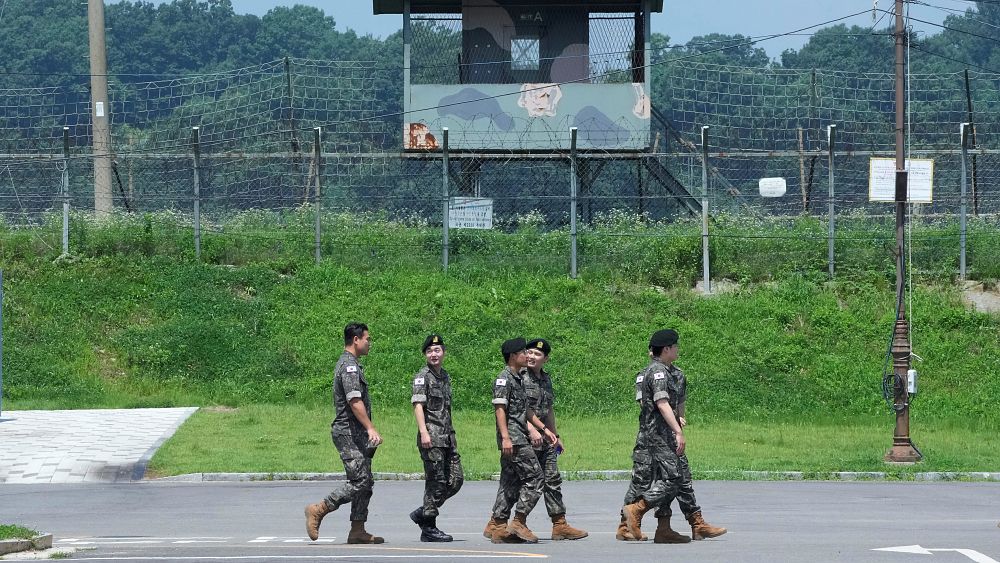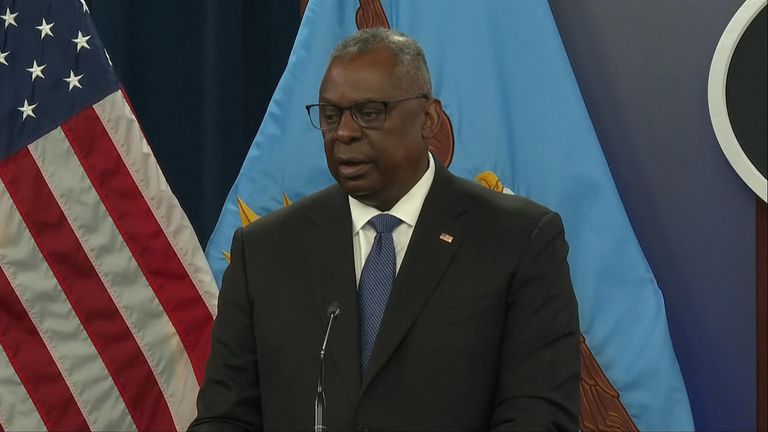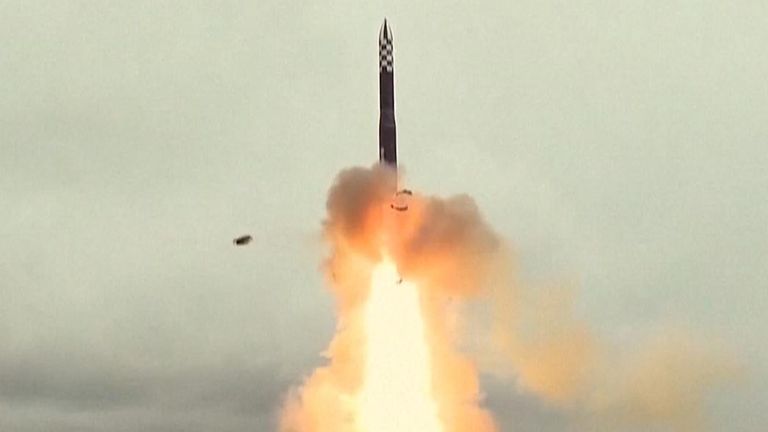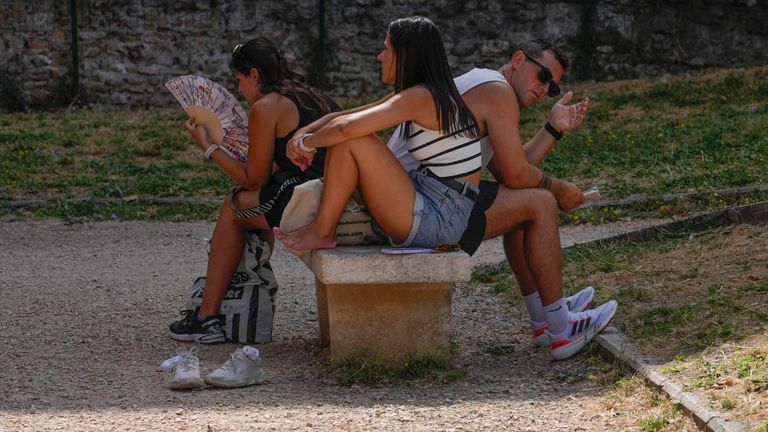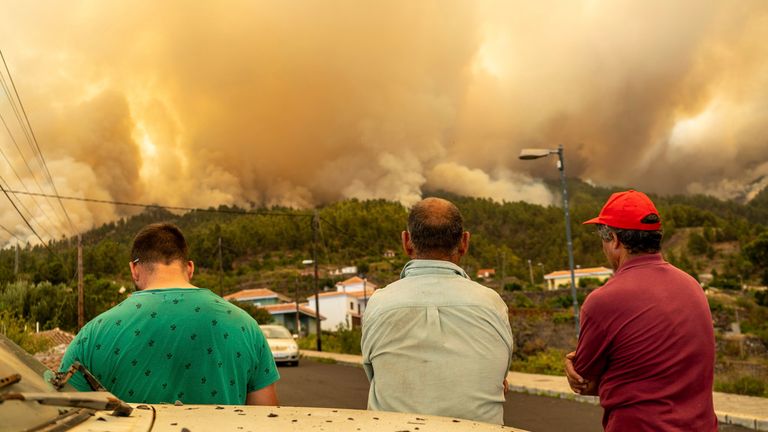Russia launched strikes on Ukraine‘s southern Odesa region, the local governor said early Wednesday, the second consecutive night of attacks on the area since Moscow pulled out of a grain export deal.
AFP: Oleg Kiper said there had been a “massive attack”, without providing details.
He asked residents to stay in shelters.
Ukraine’s air force said it had detected the launch of Kalibr missiles from the Black Sea, without giving details.
A video posted on social media purporting to show the aftermath of a strike showed a multi-storey apartment building with several windows blown out and shards of glass on the street.
Air alerts were issued for more than a dozen regions across Ukraine.
On Tuesday a Russian strike damaged facilities at the port city of Odesa after Moscow pulled out of an agreement facilitating the safe shipment of grain from Ukraine.
The Kremlin later issued a veiled warning over the future of grain exports via the Black Sea, claiming Kyiv was using the export corridor “for combat purposes”.
Here is a selection of some of the most recent pictures sent to us from Ukraine and Crimea.

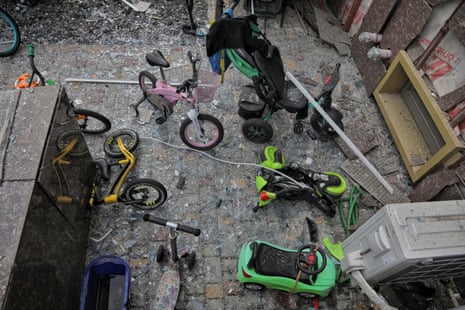

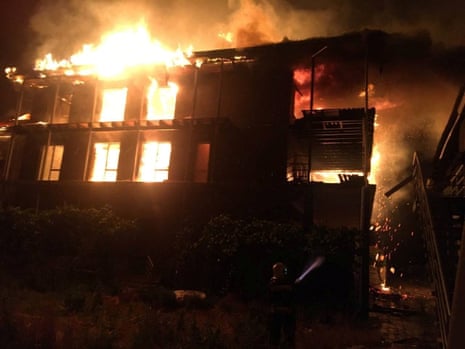
Shaun Walker is in Odesa for the Guardian:
It was a second noisy night for residents of Odesa, with numerous explosions audible from the centre of the city and officials telling residents to take cover in bomb shelters. Since Russia pulled out of the grain deal on Monday it has been targeting Ukraine’s main port city relentlessly.
A wave of missiles and drones were used in the overnight attacks, most of which were intercepted by Ukrainian air defences. Various residents shared videos on Telegram of damage to windows or shrapnel damage from falling debris, but was it not immediately clear if there were casualties in the city.
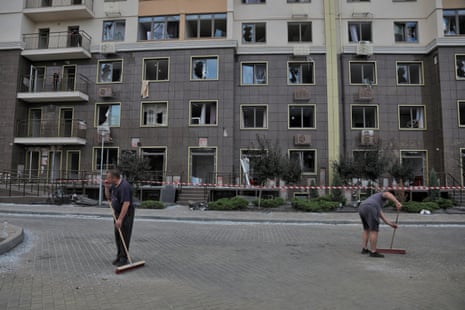
Ukraine’s Air Force said six high-precision Onix missiles were directed at Odesa’s port, where yesterday USAid chief Samatha Power held a press conference.
On Wednesday morning, authorities reported they were battling a fire in the broader Odesa region after Russian incoming hit warehouses containing fireworks and tobacco. One person was injured there.
Suspilne, Ukraine's state broadcaster, has posted this latest news update from Odesa. It writes:
During the night attack on Odesa region, rockets hit the grain and oil terminal, damaged tanks and equipment for loading, and a fire broke out, said Vladyslav Nazarov, the spokesperson for the “South” command.
In the Odesa region, an industrial facility was hit, where an employee was injured, and two warehouses in different locations were also hit – with tobacco and fireworks.
Also, as a result of combat work, several apartment buildings were damaged by an explosive wave in residential complexes of Odesa. At least six residents of Odesa, including a nine-year-old boy, sought medical help after being injured by fragments of glass and other objects.
The claims have not been independently verified.
Jamie Wilson, who is in Odesa for the Guardian, reports that, after a night of intense Russian attacks, “it is business as usual in central Odesa this morning, with lots of cars and buses and people going off to work.”

Ukraine’s air force said on Wednesday it downed 37 out of 63 targets in an Russian overnight missile and drone attack, including 23 suicide drones and 14 cruise missiles.
The air force said critical infrastructure and military facilities had been attacked in the nighttime strikes, and that the main target was Ukraine’s southern Odesa region.
Reuters reports that Serhiy Bratchuk, spokesperson for the Odesa military administration in Ukraine, has posted two videos which purport to show fire in an uninhabited area of Crimea, saying, “Enemy ammunition depot. Staryi Krym.”
Staryi Krym is a small historical town in the Kirovske district of Crimea, the peninsula that Russia unilaterally annexed from Ukraine in 2014.
The fire comes two days after a blast damaged a bridge linking Russia to Crimea that Moscow blamed on Ukraine.
Vitaliy Kim, governor of Mykolaiv, reports on Telegram that overnight, after a Russian attack, “recreational infrastructure facilities in a coastal zone were destroyed and set on fire. Detailed information is being clarified. Two people were injured, one of them was hospitalised.”
Most of Ukraine was under air raid alerts on and off starting soon after midnight on Wednesday, with Russia striking other places, including a drone attack on Kyiv.
“A difficult night of air attacks for all of Ukraine, especially in the south, in Odesa,” Serhiy Popko, head of the Kyiv’s city military administration, said on the Telegram channel.
He said Kyiv was attacked and according to preliminary information there was some damage or casualties.
The Moscow-backed governor of Crimea has just said on Telegram that 2,000 people will be evacuated as a result of the fire.
Governor Sergei Aksyonov wrote:
The temporary evacuation of residents of four settlements - that’s more than two thousand people - is planned from the area adjacent to the landfill in the Kirovsky District. The operational headquarters has been deployed, all specialized services are working on the spot.
A fire broke out at the military training grounds in the Kirovske district on the Crimean Peninsula, the Moscow-backed governor of Crimea said on Wednesday.
The fire forced the closure of the nearby Tavrida Highway, Russian-installed Governor Sergei Aksyonov of Crimea said on the Telegram messaging app.
Earlier, the RBC-Ukraine news agency reported that there were explosions on the military training grounds.
Russia launched strikes on Ukraine‘s southern Odesa region, the local governor said early Wednesday, the second consecutive night of attacks on the area since Moscow pulled out of a grain export deal.
AFP: Oleg Kiper said there had been a “massive attack”, without providing details.
He asked residents to stay in shelters.
Ukraine’s air force said it had detected the launch of Kalibr missiles from the Black Sea, without giving details.
A video posted on social media purporting to show the aftermath of a strike showed a multi-storey apartment building with several windows blown out and shards of glass on the street.
Air alerts were issued for more than a dozen regions across Ukraine.
On Tuesday a Russian strike damaged facilities at the port city of Odesa after Moscow pulled out of an agreement facilitating the safe shipment of grain from Ukraine.
The Kremlin later issued a veiled warning over the future of grain exports via the Black Sea, claiming Kyiv was using the export corridor “for combat purposes”.
Welcome back to the Guardian’s live coverage of the war in Ukraine with me, Helen Sullivan.
Our top stories this morning: Russia launched strikes on Ukraine’s southern Odesa region, the local governor said early Wednesday, the second consecutive night of attacks on the area since Moscow pulled out of a grain export deal.
Oleg Kiper urged residents to stay in shelters, before declaring the air alarm suspended, without providing details on damage.
And a fire broke out at the military training grounds in the Kirovske district on the Crimean Peninsula early on Wednesday morning, the Moscow-backed governor of Crimea said.
The fire forced the closure of the nearby Tavrida Highway, Russian-installed Governor Sergei Aksyonov of Crimea said on the Telegram messaging app. Earlier, the RBC-Ukraine news agency reported that there were explosions on the military training grounds. Neither the Guardian nor Reuters have independently verified the report.
Elsewhere:
Russia’s defence ministry said on Tuesday it had carried out overnight strikes on two Ukrainian port cities in what it called “a mass revenge strike” a day after an attack on the Kursk Bridge, which it blamed on Kyiv. The ministry claiming thats it hit “facilities where terrorist acts against the Russian Federation were being prepared using crewless boats, as well as at the place of their manufacture at a shipyard near the city of Odesa”, and fuel depots in Mykolayiv.
Russia and Ukraine presented vastly different accounts of fighting in northeastern Ukraine on Tuesday, with Moscow reporting advances by its troops and Kyiv saying it had seized the initiative in the region. Both sides reported no letup in the fighting. Ukraine has reported a measure of progress in a counteroffensive launched early last month in the east and in capturing villages in the south, while Moscow says it has contained any move forward by Kyiv’s forces.
Both sides have achieved “marginal advances” in different areas over the past week, the UK’s Ministry of Defence has said in its latest intelligence update on the conflict.
There are a “number of ideas being floated” to help get Ukrainian and Russian grain and fertiliser to global markets after Moscow quit a deal allowing the safe export of Ukraine grain through the Black Sea, the United Nations said on Tuesday.
The head of USAid accused Putin of making a “life and death decision” affecting millions of the world’s poorest people by withdrawing from the Black Sea grain deal. Speaking in the shadow of several vast grain silos in the key trading port of Odesa, Samantha Power pledged a further $250m to create and expand alternative routes for Ukrainian grain to leave the country, but admitted nothing would compensate for the loss of the Black Sea ports.
The Russian foreign minister, Sergei Lavrov, discussed with his Turkish counterpart, Hakan Fidan, ways of exporting Russian grain via routes “that would not be susceptible to Kyiv and the west’s sabotage”, Russia’s foreign ministry said on Tuesday.
South African President Cyril Ramaphosa has asked permission from the international criminal court not to arrest Russia’s Vladimir Putin, because to do so would amount to a declaration of war, a local court submission published on Tuesday showed. South Africa is due to host a summit of the BRICS club of nations – Brazil, Russia, India, China and South Africa – next month. But the ICC has an arrest warrant out for Putin, accusing him of the war crime of deporting Ukrainian children to Russia. South Africa, as an ICC member, is obliged to arrest him should he appear in person at the summit.
An investigation has identified military units under Russia’s command that carried out human rights abuses last year during the occupation of the Ukrainian city of Izium. The report by the Centre for Information Resilience names four militia units that allegedly abused civilians and prisoners of war.
US General Mark Milley said in a Pentagon briefing that Ukraine’s counteroffensive is far from a failure but the fight ahead will be long. He said: “I think there’s a lot of fighting left to go and I’ll stay with what we said before: This is going to be long. It’s going be hard. It’s going to be bloody.”
Ben Wallace, the outgoing UK defence secretary, said the war in Ukraine is “winnable”, arguing the Nato alliance “does function” as a deterrent against Russia at the Tony Blair Institute for Global Change conference in London.
Russia’s parliament has extended the eligibility for military call-up by at least five years – in the case of the highest-ranking officers, up to the age of 70.
Britain’s Ministry of Defence said on Tuesday it plans to invest £2.5bn ($3.3bn) in army stockpiles and munitions “to improve fighting readiness”, as it “takes learnings from the war in Ukraine”.
Russian air defences and electronic countermeasure systems downed 28 Ukrainian drones over Crimea in the early hours of Tuesday, the RIA news agency has cited the Russian defence ministry as saying. The drone attacks caused no casualties or damages, the ministry said.
Russian state-owned media is reporting that Russian Federation security services claim to have detained a woman on suspicion of preparing “a terrorist attack” in the Yaroslavl region, to the north of Moscow.
https://news.google.com/rss/articles/CBMipQFodHRwczovL3d3dy50aGVndWFyZGlhbi5jb20vd29ybGQvbGl2ZS8yMDIzL2p1bC8xOS9ydXNzaWEtdWtyYWluZS13YXItbGl2ZS11cGRhdGVzLW1vc2Nvdy1hdHRhY2tzLW9kZXNhLWNyaW1lYS1taWxpdGFyeS1iYXNlLWZpcmUtZXZhY3VhdGlvbi1raXJvdnNrZS10YXZyaWRhLWhpZ2h3YXnSAaUBaHR0cHM6Ly9hbXAudGhlZ3VhcmRpYW4uY29tL3dvcmxkL2xpdmUvMjAyMy9qdWwvMTkvcnVzc2lhLXVrcmFpbmUtd2FyLWxpdmUtdXBkYXRlcy1tb3Njb3ctYXR0YWNrcy1vZGVzYS1jcmltZWEtbWlsaXRhcnktYmFzZS1maXJlLWV2YWN1YXRpb24ta2lyb3Zza2UtdGF2cmlkYS1oaWdod2F5?oc=5
2023-07-19 04:42:00Z
2203024599
